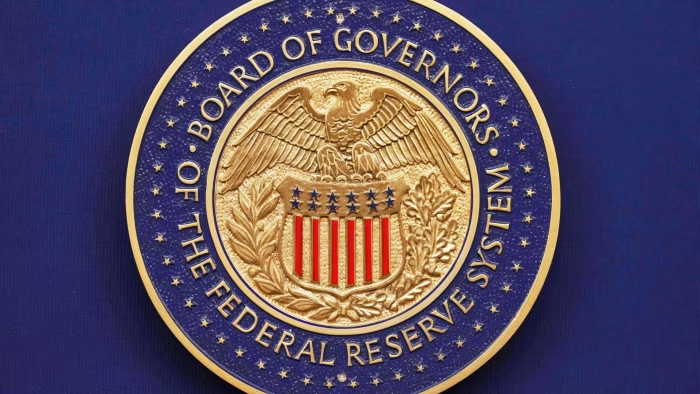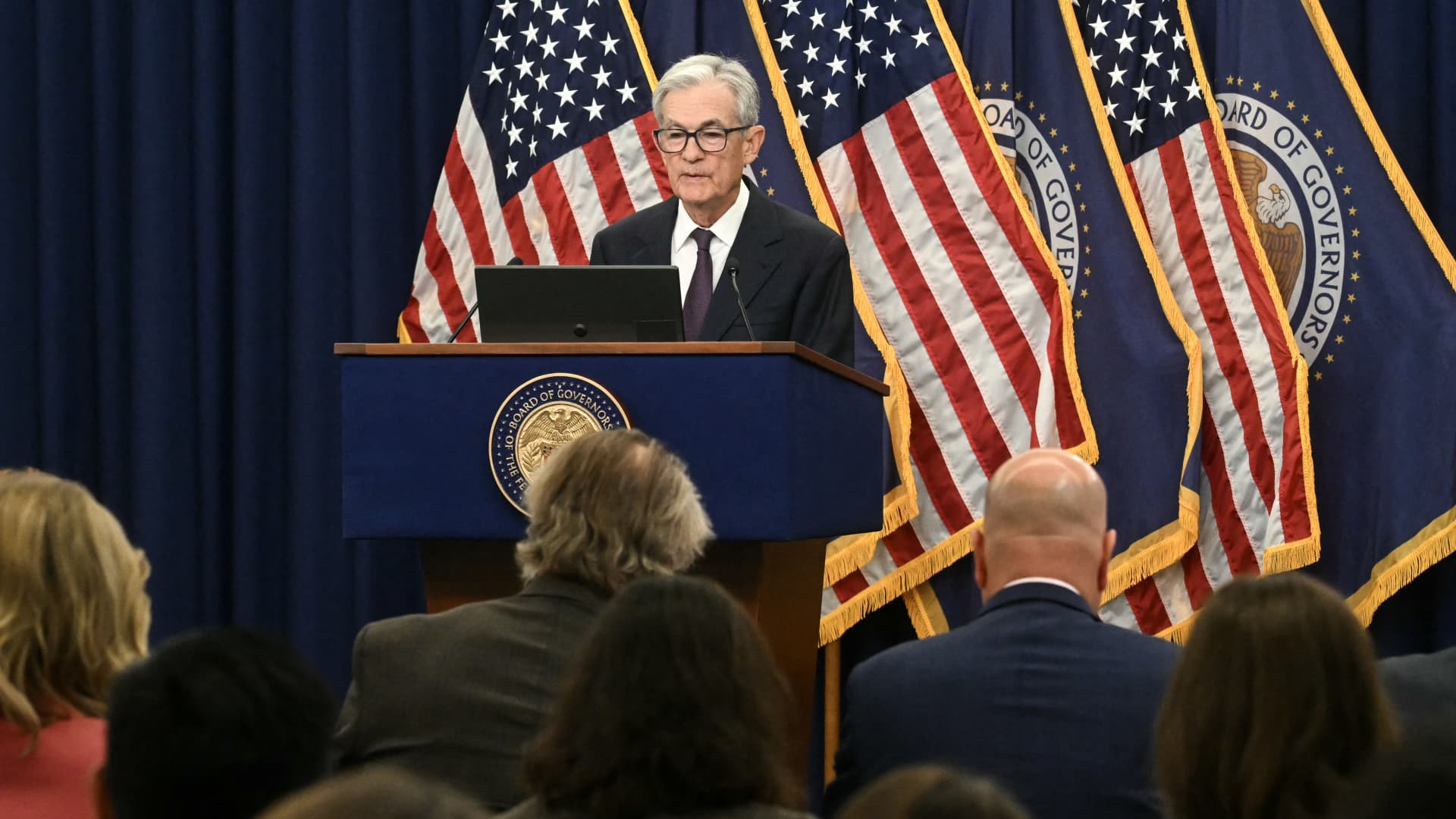An amateur footballer and NHS worker has been left with a fractured skull after being attacked by a group of “more than 10 spectators” during a match in Liverpool.
Ormskirk West End Football Club said one of their players, Richard Agbasoga, was…

An amateur footballer and NHS worker has been left with a fractured skull after being attacked by a group of “more than 10 spectators” during a match in Liverpool.
Ormskirk West End Football Club said one of their players, Richard Agbasoga, was…

Unlock the Editor’s Digest for free
Roula Khalaf, Editor of the FT, selects her favourite stories in this weekly newsletter.
The Federal Reserve cut US interest rates by a quarter point on Wednesday, but warned that a further reduction this year was not a “foregone conclusion” as a government shutdown clouds the outlook.
Concerns about weak job growth coupled with signs of funding tightness in money markets prompted the Fed’s move to halt efforts to shrink its balance sheet, starting in December.
But Wednesday’s decision to lower the benchmark rate to 3.75 per cent to 4 per cent drew some dissent on the 12-member Federal Open Market Committee, casting further doubt on its strategy at the next meeting in December.
“A further reduction of the policy rate at the December meeting is not a foregone conclusion,” Fed chair Jay Powell told reporters after the meeting on Wednesday.
“I always say that it’s a fact that we don’t make decisions in advance. But I’m saying something in addition here: that it’s not to be seen as a foregone conclusion — in fact far from it.”
Stocks fell sharply on Powell’s comments, with the S&P 500 down 0.3 per cent. Rate-sensitive two-year Treasury yields climbed to 3.57 per cent, up 0.08 percentage points.
Markets had bet heavily on the prospect of another quarter-point cut this year, pricing in a 87 per cent chance of another move in December ahead of Powell’s remarks. The odds of a cut fell to 74 per cent after Powell’s remarks.
“The ‘far from it’ part was kind of unnecessary, and heavily loaded,” said TS Lombard economist Dario Perkins. “He intended to send a signal, and the FOMC clearly wants to go into its meeting in six weeks’ time with its options open.”
The meeting came almost one month into a federal government shutdown, which has left the central bank without some economic data it relies on to make its decisions.
“This rate cut was the easy part,” said Eswar Prasad at Cornell University. “The Fed could soon be flying blind, rendering it bereft of the data markers that typically guide its policy decisions and therefore exposing it even more to political pressures.”
Powell said the dearth of adequate data caused by the shutdown would also be a factor in the FOMC’s thinking.
“What do you do when you’re driving in the fog? You slow down,” said Powell, adding that there was “a possibility” that this would influence the debate on December 10.
Dissent to Wednesday’s decision came from Kansas City Fed president Jeffrey Schmid, who called for rates to remain on hold, while Fed governor Stephen Miran, an ally of US President Donald Trump, backed a deeper half-point cut.
Powell said that an array of forecasts and approaches to risk among policymakers “were reflected in strongly differing views in today’s meeting”.
Alongside the rate move, the FOMC announced it was pulling back from its quantitative tightening programme amid concerns that short-term funding for some banks was becoming too tight.
The New York Fed would begin reinvesting all the proceeds of maturing Treasury debt held by the central bank into the government debt market from December 1, the committee said.
The Fed will also reinvest $35bn a month from maturing mortgage-backed securities into the Treasuries market from December 1.
Powell said there had been “a more significant tightening” in money market conditions over the past three weeks. “We’re shrinking the balance sheet at a very slow pace . . . There’s not a lot of benefit to shrinking it by the last few dollars.”
The move to cut the benchmark rate to between 3.75 per cent and 4 per cent, which was widely expected, leaves it at its lowest level since late 2022 — and follows months of pressure from Trump to slash borrowing costs.
The FOMC said the downside risks to employment “rose in recent months”. Amazon, UPS, Target, General Motors and other US companies have announced thousands of job cuts in recent days.
“Conditions in the labour market seem to be gradually cooling,” Powell said, though he later added that this was mostly down to Trump’s immigration crackdown. “There’s not a supply of workers showing up for jobs.”
Wednesday’s cut, the second in a row, also comes after a campaign waged by Trump to push the Fed to dramatically lower borrowing costs.
The Fed bought trillions of dollars of Treasuries after the Covid-19 pandemic, increasing its balance sheet to $9tn and flooding the financial system with cash.
Since 2022, the central bank has pulled back, allowing Treasuries and government mortgage-backed securities to mature without buying replacements.

To look purely at the scorecard, England were thumped by South Africa.
They were made to rue electing to bowl, with the Proteas, led by Laura Wolvaardt’s superb 169, piling on 319-7.
It left England requiring their highest successful women’s ODI…

One of nature’s most beautiful natural wonders, spider webs sometimes feature little extra bits of flair called stabilimenta. Stabilimenta are highly-reflective UV structures. Basically, think of them like spidey bike reflectors scattered…

The thing about carrying multiple devices is you usually end up hauling a nest of cables along with them. Now imagine trimming your kit down to a single, versatile cord that can provide power to your smartphone and laptop simultaneously. That’s…
This request seems a bit unusual, so we need to confirm that you’re human. Please press and hold the button until it turns completely green. Thank you for your cooperation!
This request seems a bit unusual, so we need to confirm that you’re human. Please press and hold the button until it turns completely green. Thank you for your cooperation!

The Federal Reserve on Wednesday approved its second straight interest rate cut, a widely expected move that came despite little recent visibility on the economy due to the government shutdown.
By a 10-2 vote, the central bank’s Federal Open Market Committee lowered its benchmark overnight borrowing rate to a range of 3.75%-4%. In addition to the rate move, the Fed announced that it would be ending the reduction of its asset purchases – a process known as quantitative tightening – on Dec 1.
Governor Stephen Miran again cast a dissenting vote, preferring the Fed move more quickly with a half-point cut. Kansas City Fed President Jeffrey Schmid joined Miran in dissenting but for the opposite reason – he preferred the Fed not cut at all.
The rate also sets a benchmark for a variety of consumer products such as auto loans, mortgages and credit cards. The reduction came even though the Fed essentially has been flying blind lately on economic data.
Other than the consumer price index release last week, the government has suspended all data collection and reports, meaning such key measures as nonfarm payrolls, retail sales and a plethora of other macro data is unavailable.
In the post-meeting statement, the committee acknowledged the uncertainty accompanying the lack of data, qualifying the way it categorized broad economic conditions.
“Available indicators suggest that economic activity has been expanding at a moderate pace. Job gains have slowed this year, and the unemployment rate has edged up but remained low through August; more recent indicators are consistent with these developments,” the statement said. “Inflation has moved up since earlier in the year and remains somewhat elevated.”
Each of those characterizations represented tweaks from the September statement. The most significant change was the view on broad economic activity. In September, the FOMC said activity had moderated.
The statement reiterated concerns that policymakers have over the labor market, saying that “downside risks to employment rose in recent months.”
Even before the shutdown, evidence had begun to build that while layoffs have been contained, the pace of hiring had flattened. At the same time, inflation has held considerably above the Fed’s 2% annual goal. The CPI report last week, released because of its importance to Social Security cost of living adjustments, showed the annual rate at 3%, pushed by higher energy costs as well as several items with direct or indirect links to President Donald Trump’s tariffs.
The Fed tries to strike a balance between full employment and stable prices. Officials lately, though, have said they see a slightly higher risk posed by the jobs picture. Along with the interest rate decision, the Fed said its process of reducing the amount of bonds it holds on the central bank’s $6.6 trillion balance sheet will end.
The program, also known as QT, had shaved some $2.3 trillion off the Fed’s portfolio of Treasurys and mortgage-backed securities. Instead of reinvesting maturing proceeds from the securities, the Fed has been allowing them to roll off the balance sheet at a limited level each month. However, recent signs of some tightening in short-term lending markets have raised concern that the roll-off has gone far enough.
An implementation note accompanying the decision indicated the Fed will be rolling proceeds from maturing securities into shorter-term bills, thus reducing the duration of its broader portfolio. Previously, the Fed had rolled the proceeds over into securities of the same maturities.
Markets recently had begun anticipating that the Fed would end QT either in October or by the end of the year. The Fed expanded its holdings during the Covid crisis, pushing the balance sheet from just over $4 trillion to close to $9 trillion. Powell has said that while the Fed found it necessary to shrink its holdings, he did not foresee a return to pre-pandemic levels.
In fact, Evercore ISI analyst Krishna Guha said he could foresee a scenario where the Fed actually restarts the purchases early in 2026 for “organic growth purposes” as market conditions shift. The Fed rarely eases monetary policy during economic expansions and bull markets in stocks. Major averages, though volatile, have been posting a series of record highs, boosted by further gains in Big Tech stocks and a robust earnings season.
History has shown that the market continues to rise when the Fed does cut under such circumstances. However, easier policy also poses the risk of higher inflation, a condition that forced the Fed into a series of aggressive rate cuts.

A newly identified genetic marker may significantly improve the ability to predict life-threatening reactions to the gout medication allopurinol in U.S. patients.
While the gene HLA-B*58:01 has long been used to screen patients in…